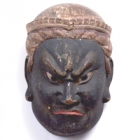Japanese Gallery (Honkan) Room 14
June 17, 2020 (Wed) - July 12, 2020 (Sun)
This thematic exhibition introduces masks worn in courtly bugaku performances and Buddhist gyōdō ceremonies in ancient and medieval Japan.
Bugaku was a ceremonial art that prospered from the Heian period (794–1192) onward and features music and dances originating in China, Korea, Vietnam, and elsewhere in Asia. The exaggerated facial expressions of the masks representing dragons, magical birds, and other creatures are particularly attractive.
Gyōdō masks were worn to represent protective deities and bodhisattvas, and parade around temple halls in Buddhist rituals. As you can probably imagine, these masks possess a more ceremonial character.

